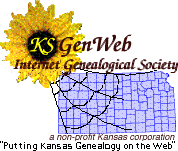Kansas Land
Johnson Co Kansas has a rich land history that includes the Louisiana Land Purchase, Treaties with the Shawnee, and Federal lands.
Federal Land Patents
Once Kansas Federal land was transferred to a buyer, a patent was issued. Shawnee Indian land held in severalty and sold to individuals also received patents. The Bureau of Land Management General Land Office (GLO) has a searchable patent index with images for Kansas: https://glorecords.blm.gov/default.aspx
Timeline of Significant Events
Louisiana Purchase, 1803
The Louisiana Purchase added the Kansas Prairie to the US Federal Lands. The future Kansas lands were closed to settlement.
Santa Fe Trail (1821)
The Santa Fe Trail opened in 1821 to Santa Fe, NM. The Trail left the United States from New Santa Fe, MO, and the first steps into the pristine tall grass prairies of the wild wild west were in what is now Johnson County. Certified trail ruts are marked and still visible in a few areas on both sides of the MO/KS state line.
Indian Territory (1825)
After beening coined the Great American Desert by Zebulon Pike in 1806, the Kansas Prairie became Indian Territory. The current inhabitant - the Kansa (Kaw) and the Osage - ceded their land and were relocated to land given in reservation. A treaty with the Shawnee wsa signed that same year to reserve land for the Shawnee. This land included the entirety of Johnson Co and extended to near Topeka.
Occupation of Land (1828)
The Fish band of the Shawnee tribe were the first to arrive to occupy their reservation in 1828. That same year, the Choteau brothers fur traders negotiated a treaty with the Shawnee and the Wyandot for land that extended from Wyandotte Co into Johnson Co, in present Shawnee. They established a trading post in Wyandotte Co and were the first non-Indian residents.
In 1830 the first Methodist Mission (Rev. Thomas Johnson) was established near the Choteau trading post in Wyandotte Co.
1831 treaty with the Shawnee to establish a Baptist Mission
By 1832 the Black Bob band of Shawnee arrived and occupied the southern portion of the reservation.
1833 Quaker treaty with Shawnee to establish a Friends mission in Johnson Co.
1839 Methodist treaty with Shawnee to establish a Mission and Manual Labor School in Johnson Co. (Rev. Thomas Johnson)
Kansas-Nebraska Act (1854)
The Kansas-Nebraska Act marks the beginning of the Kansas Territory and opened the door to settlement. Prior to 1854, the land was Indian Territory divided into reservations. In preparation for entry to the US as a Territory, reservation land had to be freed up. New treaties were written to provide a land allotment (in severalty) for each person. Land ownership was a concept that was counter to the Native culture. As a result, the Black Bob band refused severalty and took their 200,000 acres as communal and were encouraged to take allotments. Much of the Black Bob land was sold to speculators as the Black Bob moved south to Indian Territory (OK). The Fish band did take their land in severalty but many began to leave for Indian Territory. Due to so much speculative buying, land sales had to be approved by the Bureau of Indian Affairs.
Scrips / Warrant Act of 1855 (10 stat. 701)
Under this Act, a scrip (receipt) for purchase of Federal land, was issued as payment for military service. Many of these claims were granted in Johnson County. The scrip were transferable and many were sold for cash. Once the warrantee sold a scrip for land, the purchaser received a Federal patent.
Free State of Kansas (1861)
Homestead Act of 1862
This Act provided settlers the ability to stake a claim, make improvements, and in 5 years apply for patent, free and clear for the cost of the filing fee. The homesteader was required to live on the land, build a 12X14 dwelling, and grow crops. Patents were approved by the General Land Office.



